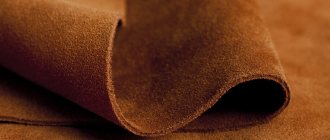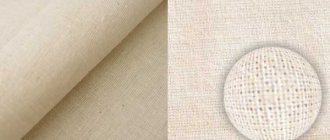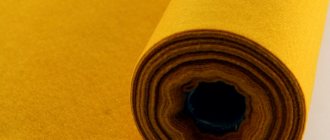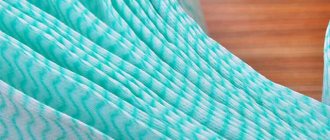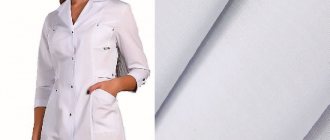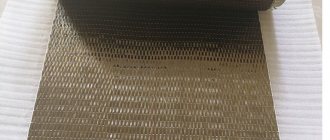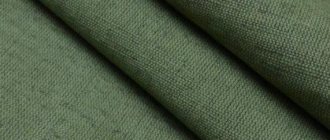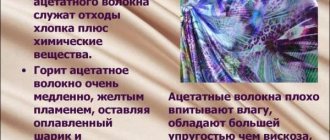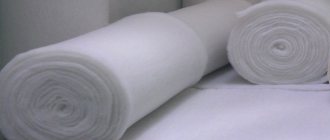Batting
is a knitted or non-woven fabric made of cotton, wool or wool blend yarn with fleece, used for household purposes as insulation.
According to its characteristics, this material is very similar to cotton wool. It is just as warm and airy. Batting (in French ouatine ) is the name given to the cotton wool material used for lining, the basis of which was mesh fabric.
Many people associate the word “batting” with the concept of old-fashioned winter clothing - good quality, very warm, but at the same time heavy and somewhat clumsy. Meanwhile, this material has long been the most popular heat-insulating textile, which was used not only for clothing, but also for many other purposes. padding polyester are now widely used for everyday winter wardrobe , there are many industries where practical and reliable batting still remains unrivaled.
What is batting?
Like many other types of textiles, this heat-insulating material began to be produced in France (the literal translation of the word ouatine is fleece).
In search of a cheap replacement for the traditional fur lining of winter clothing of the time, a non-woven material was invented, consisting of cotton or wool wadding attached to a mesh fabric.
Batting has been extremely popular and in demand in the past century. It insulated not only work clothes, but also the winter outfits of city dandies. Fashionistas of the 40s and 80s of the 20th century did not refuse it even in evening dresses: hangers for blouses, dresses and jackets were made from this material.
Warm and inexpensive batting, especially wool, quickly gained popularity not only among people of low income. Even wealthy ladies appreciated its ability to create a fairly thin and dense padding, which not only warmed, but also gave the silhouette clarity and the shape required by fashion. Batting padding was used for women's coats and jackets, forming fluffy folds of skirts and creating puffs on the shoulders, and warm hats. Shoulder pads made of this material were a mandatory part of a fashionable wardrobe in the middle of the last century, and returned briefly in the eighties, although then padding polyester , foam rubber and other pads were already used for this purpose.
The secret of the cheapness of batting was that they used cheap raw materials - not very high-quality cotton , scraps of wool and cotton fabric, and even linen waste. The production scheme of this non-woven material has not changed for centuries:
- Collection and preparation (cutting) of raw materials, mixing them in the required proportions if necessary;
- Regeneration, that is, the separation of raw materials into fibers using pinching machines.
- Combing fibers and distributing them evenly;
- The formation of an insulating layer of specified dimensions and density can be carried out in one or several layers.
- Quilting the insulating layer, as well as fastening it to the fabric.
According to the method of fastening the fabric, batting is divided into:
- non-woven needle-punched, when the fibers are fastened together with vertically arranged dense stitches. It is inexpensive, soft, although it does not have very high heat-insulating properties and wears out quickly.
- The knitting and stitching material is fastened with cotton or synthetic threads, the stitches of which are arranged in a herringbone pattern. It is more durable, although more expensive than its needle-punched counterpart.
- durable and dense batting on gauze that does not shrink, but is now produced quite rarely.
The most expensive is wool material, which provides the same thermal insulation as real fur . It is practically non-flammable, so it is better suited for workwear intended for high-temperature environments. In second place for these purposes is cotton batting on gauze. However, most modern materials in this group are made from a mixture of recycled wool yarn, cotton and synthetics. For technical batting, the addition of flax “shaking” is also used - sorted short flax fibers.
Features, characteristics of batting, description of batting fabric
Ouatine, which means “fleece” in French, is a non-woven or knitted fabric made from natural fibers of plant or animal origin: cotton, wool, cellulose. The material is porous and has good thermal insulation properties. The material is produced in three ways. In the first, the warp is stitched with parallel seams with large stitches on a gauze pad, in the second, it is pierced on looms with multiple needles and then stitched. In the third, the fibers are stitched with a zigzag.
Wool batting has increased heat-resistant properties.
What does it consist of, what does it look like
Produced from textile industry waste. Scraps from a variety of materials are recycled: cotton, cotton (uluk), wool, linen, synthetic waste. Wool batting is more expensive, since natural wool is used, it has increased thermal insulation properties. Manufacturers produce 100% cotton material, viscose fabric and other polyester materials. The mixed type of batting fabric is popular. Externally, the material resembles stitched white, blue or grayish-pink cotton wool. It can be compared to bouclé fabric; its loose structure contains threads and knots.
Properties, quality, density
Batting has high thermal properties, as well as:
- breathability, the material allows air to pass through well;
- hygroscopicity, the products absorb moisture; for household purposes, special batting is produced that can be used to wash the floor;
- hypoallergenic, the natural composition of the canvas does not cause skin irritation, batting is recommended as a filler for children's mattresses.
- sound insulation, the material has sound-absorbing properties;
- the stitched fabric is durable;
- the material has a loose structure, density varies from 90 to 1000 g/m2;
- low cost.
Advantages and disadvantages
Batting is a fairly warm and durable material. Products with this filler are comfortable and pleasant, they retain heat well and allow air to pass through. Since the production uses exclusively waste from the textile industry, batting is also a cheap material. Negative properties include the rapid wetness of the canvas and significant weight. Wet items become very heavy. Moths can live in wool batting.
The disadvantages include the pilling of the material; over time, things made from batting become unevenly thinner, and bald spots appear in places.
Production technology and material manufacturing
All waste from the textile industry is passed through fulling presses and machines, the material is compressed and rolled. Individual scraps are transformed into an almost homogeneous material. Among all types of batting, the most expensive is wool. In terms of its properties, it is not inferior to insulation made from natural fur. Advantages include heat resistance; wool batting does not support combustion. It produces batting fabric in three ways:
- By piercing with triangular needles.
- The base is fixed with a large zigzag stitch.
- By laying the base on a gauze cloth.
Manufacturing methods and price differences
Batting is made from sewing waste, such as wool , viscose , cotton lint, cotton wool, etc. The scraps of these materials undergo special processing and are rolled into fabric. There are several ways to make such material.
According to the manufacturing method, batting is a non-woven or knitted material. It can be based on sewing or weaving waste. Synthetic, natural or regenerated fibers undergo special processing, after which they become loose and fluffy. They are evenly distributed and joined by special machines.
- Needlepunched . Equipped with tightly spaced needles. They bind the fibers with vertical stitches. This type of batting is sometimes called non-woven needle-punched fabric. This type of material is not very durable, but has the lowest cost.
- Knitting and stitching . It binds the fibers together with very decorative parallel stitches, reminiscent of a herringbone pattern. The batting is called canvas-stitched . It is more durable than the first, but also costs 20-25% more due to the use of additional cotton or synthetic threads for stitching.
The most expensive and durable fabric is fabric placed on gauze. This technology eliminates deformation of products and increases their service life.
The cheapest is non-woven needle-punched batting. It is made by fastening fibers together with many needles. The disadvantage of this canvas is that it is not very durable. Canvas stitched fabric is more expensive because its fibers are sewn together in parallel stitches using cotton threads. This fabric has a longer service life due to good bonding.
There is another type of non-woven fabric, which is much more expensive than the previous two. It is sewn onto gauze so that it does not deform over time. Due to the use of materials such as gauze and thread, lined batting costs several times more. Since the insulation itself rolls off and wears out over time, this technology significantly increases its service life. The color of the canvas depends on what raw materials it is made from. wool was used for production , then it is usually gray , if cotton fabrics were used - white .
Kinds
According to the method of connecting fibers, they are distinguished:
- needle-punched batting. The “cotton wool” is fastened using special needles with burrs - the result is a rather loose fabric;
- canvas-stitched (quilted). Loose fibers are stitched with a zigzag stitch, and gauze backings are used. This increases the wear resistance of the material.
The composition of batting can be wool, half-woolen, cotton, jute and synthetic. It is rarely dyed, so the type of fiber can be determined visually.
Cotton fabric is white-yellow, wool - gray-blue, jute - golden brown. Multi-colored batting is made from waste materials.
The material also varies in density. On sale you can find both thin, delicate canvases with a thickness of 3 mm, and very thick ones - 12 mm. The highest batting density is 1000 g/m².
Batting sheets last from 7 to 15 years. Over time, their structure becomes heterogeneous. If desired, this can be corrected by redistributing (pinching) the insulation and quilting.
Knitted
It is considered the best insulation for clothing among all types of batting. Being flexible and elastic, it exactly repeats the silhouette and is easy to cut. It does not need to be further strengthened with gauze or other fabrics. Knitted batting is produced on Rachelle machines. The raw materials are cotton waste, overlock scraps, wool and wool-blend pieces of fabric. Often the material is brushed on one or both sides. It can be painted or harsh.
Driven in
It is combed cotton wool driven into a frame - cotton fabric with sparse weaving. The most commonly used raw materials are tow and viscose. The fabric is made on a needle-stuffing machine. It turns out fluffy, wear-resistant, but not highly elastic.
Rolled
It is made mainly from wool with the inclusion of additional materials. The wool is combed on special machines into canvas. Then they are moistened and hot glued together. At the final stage, several layers of rolled material are quilted.
Knitting and stitching
The finished canvas resembles a quilt. The raw materials are pinched, formed into layers and stitched with cotton or synthetic threads. The thread loops hold the fibers securely. The material is highly durable and wear-resistant. But you need to take into account that such a fabric will cost 2 times more than one made using the needle-punched method.
On a gauze basis
The most durable and dense type of batting. It doesn't shrink. The fibers are placed on a gauze base and additionally secured with large stitches. Previously, it was called “woolen canvas batting stitched on a backing.” Nowadays such material is practically not produced.
Batting is insulation that will prevent you from freezing
As a rule, a good insulation for clothing should have several properties: it should be durable, retain heat and allow the body to breathe. Non-woven fabric undoubtedly has all these advantages. It is very soft to the touch and quite warm. The composition includes only natural materials that allow the batting to “breathe”. It very rarely causes allergies in people.
Batting also differs in the following parameters.
- By density . This is the most important characteristic of the material. The scope of its application depends on it. The density of products varies from 90 g/m to 1000 g/m. However, the most used materials have indicator values of -200-400 g/m.
- By composition .
- The most expensive fabrics are made from natural raw materials.
- 100% cotton. Wear-resistant and durable, they are easier to sew.
- 100% wool. The most expensive ones are made from excellent, non-flammable yarn. They are heavier and thinner than cotton, absorb moisture well and have excellent heat resistance.
- Cheaper products are made from viscose or polyester fibers. They are characterized by low creasing and wear resistance.
- Linen batting is well known to builders. It is made from short fibers – the so-called “shake” – waste from flax spinning.
- The most popular and in demand is wool blend material, which contains 30% wool and 70% cotton, viscose or synthetics.
- By color . Cotton fabrics are usually white, yellowish or light gray. Woolen ones are gray, they have the color of undyed wool. If the fabric is made from the remains of colored yarn, it is variegated.
- By thickness . Products are available in thicknesses from 3 to 12 mm.
Types and their properties
The special characteristics of the material allow it to be used in various fields. For this reason, the following types of filler are distinguished:
- garden batting is a covering material for garden plants. It allows steam to pass through, allows moisture to escape into the soil and retains heat. It is used under a frame, less often - independently. Suitable for perennial flowers that cannot withstand low temperatures;
- furniture - mixed and artificial filler is used in the manufacture of upholstered furniture; cotton and wool batting is suitable for sewing blankets, pillows and other bedding;
- construction – used as insulation and soundproofing material. Used as a substrate for floor coverings. Jute batting has become widespread in the insulation of wooden houses;
- clothing and footwear – insulates outerwear, is used when sewing work uniforms and workwear, and is suitable for shoe lining.
The material is also classified according to composition, production technology and properties:
- needle-punched - the cheapest and short-lived material, has a non-uniform color. It is used mainly for cleaning, as an affordable technical insulation;
- canvas-stitched batting - also knitting-stitched or thread-stitched. It is easily recognized by its zigzag stitching. This batting resembles a quilt and varies in thickness and composition. Cotton insulation is usually white or light beige, and wool insulation is gray or with a brown tint. Wool blend batting can be light grey.
- on gauze - is a stitched batting after connecting the non-woven fabric with a gauze base. This insulation does not deform and lasts longer, but is expensive.
Properties and Features
Batting has many desirable qualities.
- This is quite warm and reliable material.
- The products are distinguished by high noise-absorbing properties.
- Environmental friendliness and safety . The material easily absorbs and evaporates moisture and allows air to pass through well. Its safety is evidenced by the fact that according to GOST requirements, the use of batting is mandatory for mattresses for a crib.
- Negative characteristics include weight. Batting is a relatively heavy fabric even in dry weather. At high humidity, it can quickly absorb water and become even heavier.
- It should be remembered that over time it rolls off and forms sparse areas in the insulation.
- Wool batting can harbor moths.
Characteristics and application of batting
Batting can be used as insulation for sleeping bags.
Despite the fact that synthetic insulation materials such as holofiber are becoming increasingly popular, textile batting is still produced in large quantities. Main advantages of the material:
- heat retention - loose fibers warm well, retain warm air and do not allow cold air to pass through;
- reliability - the batting is wear-resistant, practical, well resistant to tears and other damage;
- noise absorption - does not transmit sound well, some types of material are used in construction;
- hygroscopicity – absorbs and quickly evaporates moisture;
- safety - does not cause allergies, suitable for use in children's rooms, as well as for creating children's products;
- the insulation does not wrinkle.
Flaws:
- batting is a heavy material, it only adds weight by absorbing moisture in wet weather;
- over time, the material rolls off;
- with prolonged use, the batting becomes deformed, becomes thinner, and sparse areas form;
- Natural wool material should be protected from moths.
Due to its simplicity, reliability, availability and ability to retain heat, batting is widely used to create a wide variety of things:
- work clothes and overalls;
- sleeping bags;
- balaclavas;
- mittens;
- lining for pants and outerwear;
- elements of soft toys;
- packaging for fragile items;
- shoe lining;
- fillers for upholstered furniture;
- ironing board;
- bedding (mattresses, pillows, blankets);
- insulation and sound insulation of residential premises;
- underlay for flooring (used under linoleum);
- cleaning products (napkins, floor rags).
Why do you need batting?
The use of batting is due to its good performance qualities:
- high thermal insulation for both low and high temperatures;
- ability to absorb noise;
- environmental friendliness.
Batting is an insulation material that is used as insulation for work clothes: it allows air to pass through well and retains heat well. Using batting as a lining for workwear allows you to create suits and jackets for working in cold conditions.
The main disadvantage of batting is its heavy weight (the most popular types of this material have a density of 200-400 g/sq. meter). The ability to absorb moisture well could be considered an advantage, but a wet cotton layer becomes very heavy and dries with great difficulty. In addition, the fibers in it roll down and are distributed unevenly over time, and the wool insulating layer contributes to the appearance of moths.
Although this non-woven material is used quite rarely in ordinary wardrobes, it is widely used for economic and technical purposes. The ability of this textile to withstand cold and hot temperatures has found wide application in various fields. Its excellent heat-insulating and noise-absorbing properties are irreplaceable in the manufacture of:
- Workwear and equipment for extreme weather conditions ( jackets , overalls , trousers , mittens, balaclavas, sleeping bags ) - batting is used to insulate clothing for those working in extreme weather situations: miners, oil and gas producers. It is used to make quilted jackets and sleeping bags , warm mittens and balaclavas, quilted overalls , pants and jackets :
- Various household and household appliances (pot holders, soft insulating upholstery). The fabric is good in the production of soft toys, packaging and shoes. It is used to cover ironing boards and stuff upholstered furniture :
- Bedding (cotton mattresses and pillows are recommended for children's and medical institutions) - batting is used in the manufacture of spring and orthopedic mattresses; it is used to fill blankets and pillows .
- Linen wool is used in construction for thermal and noise insulation of houses, as a gasket for floor coverings.
In addition, it is used in the manufacture of mattresses and furniture. In mattresses, this material is used as the topmost layer before covering. This makes it soft and very warm. Many buyers are looking for mattresses with batting filler. Sellers can talk for hours about what kind of filler this is.
Non-woven fabric is widely used in the manufacture of pillows and blankets. The important thing is that since it breathes well, the human body does not sweat. This material is also used for industrial purposes. Doors are insulated with batting pads, which can significantly increase their thermal insulation properties. In addition, this material is also used in automobile production.
In many stores you can find warm coats and jackets insulated with material such as batting. Many people know what kind of insulation this is and therefore the demand for such things is quite high.
Application
The main use of this material is insulation for clothing. Previously, a winter coat with batting was in the wardrobe of almost every person with average income. However, with the advent of synthetic insulation, heavy batting began to lose ground. If we compare which is better, batting, or, for example, padding polyester, there is no clear answer. Synthetics are lighter, but fabric made from natural raw materials is definitely more environmentally friendly. And if we talk about what is warmer, then the indicators are approximately the same.
Nowadays, as a rule, jackets and overalls for workers are sewn from batting, as well as sleeping bags, mittens, and balaclavas.
Blankets and pillows are made from batting; it is used as a layer for spring and orthopedic mattresses.
This fabric is good as packaging and padding material; high-density (garden) batting is used to insulate the soil in snowless winters.
Disadvantages of such material
While batting has many advantages, there are also certain disadvantages. This primarily applies to fabrics with a high content of wool and cotton wool. This material is quite heavy, and since it also has hygroscopic properties (it absorbs moisture well), when water gets on it, it becomes much heavier. Cheap batting sheets also tend to pill and fray in some places, so the service life of products made from such raw materials will not exceed four years. High-quality and expensive batting, the photo of which is provided below, can retain its good appearance even after ten years of use.
Advantages and disadvantages
Professionals distinguish two types of natural batting: cotton (cotton) or wool blend . Each type has its own properties and characteristics. Cotton-based batting is more durable and wear-resistant, while woolen-based batting is heat-resistant, absorbs moisture well, but is heavy. The artificial material is durable and resistant polyester.
A product made according to GOST has many advantages:
rapid absorption and evaporation of moisture - comfort is ensured during heavy physical work; good air permeability - the batting “breathes” , that is, moist air can escape freely; noise absorption; environmental friendliness - this advantage applies to fabrics made without synthetics; natural fabric does not cause allergic reactions ; retains heat due to its porous structure and airiness; affordability.
Disadvantages include susceptibility to the formation of sparse, rolled areas . Moths can grow in woolen fabric. To avoid this, it must be treated with special means during storage. The finished product is heavy, and in wet weather it absorbs moisture and becomes even heavier.
What is better padding polyester or batting?
Modern technologies for the production of non-woven insulating materials often give preference to synthetics. The most famous among them is padding polyester - a layer of polyester fibers that can be attached to fabric or thermally stitched.
Often on sale you can see padding polyester sewn onto lining fabric - it is called synthetic batting, and, unlike real batting, it looks much more attractive thanks to the shiny lining fabric, figured stitching, and greater softness.
The main advantage that padding polyester over non-woven material made from cotton or wool is its low weight (about 100 g/sq. meter). However, synthetic fibers retain heat much worse, and such clothes will only be comfortable down to a temperature of -5 degrees.
For winter clothing, padding polyester has to be laid in two or three layers, and the advantage of its low weight disappears, but it does not absorb moisture, washes better and dries quickly. However, it should be remembered that synthetic winterizer is not suitable for work clothes, especially when there is a high possibility of contact with chemicals, sparks, or open fire; in these cases, a wool insulating layer is best suited.
Modern Applications
In the manufacture of clothing, mainly synthetic insulation is used. It consists of polyester fibers that are attached to the base by stitches or thermal methods. From an aesthetic point of view, the answer to the question of which is better will certainly be “sintepon”, since it is light in weight, very soft and allows you to perform a variety of figured stitches. However, its warming properties are low, and at temperatures below -5 degrees it is recommended to wear something warmer. The criterion by which batting material is the leader is resistance to high temperatures and chemicals, as well as low flammability. Therefore, it is recommended to use it in the manufacture of kitchen accessories (potholders), soft toys, and upholstery layer in furniture. The standards currently in force require the use of batting in the manufacture of bedding in healthcare institutions, kindergartens, etc. For reasons of light weight, polymer insulation is now used for sleeping bags and other camping gear, but they should be kept away from fire.
The main application area that requires natural batting material is industry. It is suitable for the manufacture of workwear and various protective devices when working in hot shops and in the cold. In addition, cotton and linen batting is a good shock absorber and noise absorber during the construction, installation and transportation of various structures. It is also used as a gasket when installing floor coverings.
Caring for products with batting
Materials with batting should not be machine washed. It is best to dry the batting in the fresh air, since it takes quite a long time to dry. This is explained by the fact that it absorbs moisture very well. This material should be ironed very carefully and only at a low temperature. Although batting is considered fire-resistant, it can become deformed at high temperatures.
Depending on the quality of the non-woven insulating material, it can last quite a long time, although it is better to update cotton mattresses and pillows at least every 7 years.
With prolonged use, their density may become uneven. This can be corrected by ripping out the cover , then manually redistributing and quilting the insulating layer.
If necessary, batting products can be washed, making sure first that the non-woven material does not fade.
Washing is done by hand, then the water is allowed to drain, the product is blotted with a towel and allowed to dry completely - this may take a lot of time.
What you should know about care:
- It is recommended to wash clothes containing batting by hand with regular powder or gel. In this case, you should pay attention to the color of the insulation and covering fabric. If the batting is darker, it may stain light-colored material when washed. In this case, it is better to take the item to dry cleaning.
- To avoid streaks after washing, hang the new product on hangers, wait until the water drains, after which it is blotted with a dry terry towel.
- Things with experience may have sparse places in the insulation. They are dried in a horizontal position and hung on hangers slightly damp.
Questions and answers
What is better - batting or padding polyester?
Sintepon was designed to become the best substitute for batting. It is softer, lighter, more elastic, more durable, and does not absorb moisture. However, its thermal insulation characteristics are significantly worse than those of wool batting. In addition, with the adhesive manufacturing method, synthetic winterizer can cause allergies.
How to wash batting?
It is recommended to wash clothes and other products containing batting by hand in cool water (up to 30 degrees). At the same time, it should not be strongly crushed, rubbed or twisted. The material can be ironed at low temperatures, but it is better to use a steamer. After washing, dry the product in fresh air.
To sum it up, we can confidently say that the batting has lost its former glory. The fabric, similar in its properties to cotton wool, is rarely used today as insulation for clothing. The most popular area of application is technical. Technical batting is cheap and has excellent sound-absorbing and heat-insulating properties. It is used in the construction of houses and the production of furniture.
About the terms of use
- Depending on the thickness, density and nature of use of the products, the material can serve flawlessly for different periods of time. A mattress, pillow or blanket can look decent even after 10 years. However, experts recommend changing bedding at least once every 5-7 years.
Of course, today this non-woven material is not as popular as it was in the last century. It is being replaced by modern, high-tech fabrics. But there are still areas of application where brilliance and showiness are forced to give way to practicality, reliability and cheapness. Batting continues to be the most popular utility and technical fabric today.
How to care?
Depending on the quality of the non-woven insulating material, it can last quite a long time, although it is better to update cotton mattresses and pillows at least every 7 years.
With prolonged use, their density may become uneven. This can be corrected by ripping out the cover, then manually redistributing and quilting the insulating layer.
If necessary, batting products can be washed, making sure first that the non-woven material does not fade.
Washing is done by hand, then the water is allowed to drain, the product is blotted with a towel and allowed to dry completely - this may take a lot of time.
Care instructions
Things and products made from batting insulation are quite practical, but not as durable as things with synthetic insulation. Blankets and pillows will have to be updated after 6-7 years. In order for things to retain their shape and not become deformed, you should follow the manufacturer’s recommendations. Batting insulation tolerates dry cleaning well.
Wrinkled items can be ironed with a warm iron, but it is worth remembering that when ironing, the looseness of the insulation decreases, the products become thinner and partially lose their thermal insulation qualities. With proper care, the products will last a long time.
Is it washable?
Blankets, jackets, overalls, toys with filling can be washed by hand, or machine washable at low speeds. To prevent the item from shrinking, it is recommended to wash it in warm water, up to +30°.
When washing items made from batting, use a gentle spin and dry flat.
Products with a light top and dark insulation cannot be washed, since the dark batting fades a little when washed even in cold water. It is better to dry clean such items. This also applies to soft toys made of Virginia and goat wool; a thick layer of filler will take a long time to dry after washing, and smudges may appear on the surface of the toy.
